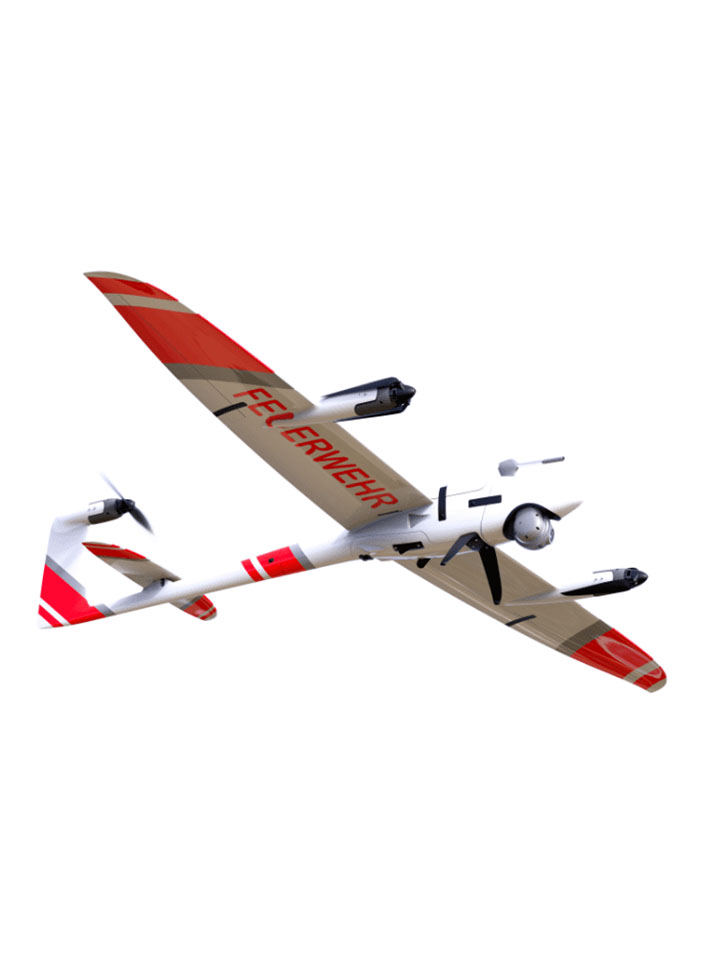

The next generation of eVTOL fixed-wing UAVs
The mathematical definition of a vector fits very well for the latest UAV from Quantum-Systems. It can face any direction: upward, forward or down. That’s exactly what Vector from Quantum-Systems is capable to do. Vertical take-off. Energy-efficient long-range fixed-wing flight and back to a vertical landing. All automatic, no pilot or operator input needed – Just fly.
VECTOR - The 2in1 vertical take-off reconnaissance UAV
Flexible and enduring, the Vector provides flight and surveillance characteristics that are exceeding performance of current UAV platforms in service all over the world.
The ability to operate in the most difficult terrain (VTOL) combined with extremely low noise emission (motor off silent mode) makes the Vector the perfect UAV for a wide range of non-invasive aerial operations.
An encrypted mesh IP link sends video streams up to a range of 15+ km. A flight time of up to 120 minutes speaks for itself. All combined in a compact and robust electric VTOL UAV.
The 2in1 System design opens up further applications with the “Scorpion” configuration – By removing the wings and attaching a separate set of copter arms a dedicated multi-copter platform becomes available for an even wider variety of mission applications. Either use a VTOL fixed-wing or a conventional copter – in both cases you only need one system to train on and to deploy it on site.
Quantum-Systems about PPK & RTK
PPK and RTK (post-processing kinematics and real-time kinematics) are the algorithms that allow the user to cancel most of GNSS errors via processing data from two receivers that are close enough to each other.
They share the same common errors for most error sources such as ionospheric and tropospheric influence on the signal transmission, satellites ephemeris and clock errors.
As is clear from the names, RTK is performed in real-time, PPK – in post-processing.
When properly applied, these algorithms reduce positioning errors from several meters (typical for standalone GNSS receivers) down to several centimeters.
The Quantum Systems current approach of choice is PPK:
- The base station on the ground must be deployed and georeferenced (if high absolute precision is required) for RTK, PPK can make use of already pre-deployed continuously operating reference stations (a dense enough network of these exists e.g. in USA, Europe, Australia, Japan). If you operate with your own reference station, the data can be logged and used in post-processing just as well.
- The real-time corrections transfer from the ground station adds additional complexity to the system for RTK, and thus reduces reliability.
- The so called forward-backward processing is possible in post-processing, which raises the precise positioning reliability.
- With our QBase mission planning software we have created a simple and straightforward process of applying PPK to your mission data. The UI enables you to choose different sources of PPK reference data to optimize your results.
- Technical Specifications
- Downloads
- Video
-
Technical data
- Max. Take-off Weight: 6.5 kg
- Max. Flight Time: 120 min
- Command and Control Range: up to 25 km
- Payload: HD40-LV EO/IR 550 g & NightHawk2 EO/IR 320 g
- Cruise Speed: 29-39 kn
- Wind Resistance (ground wind): up to 23 kn
- Wingspan: 2.8 m
- Transport Case Dimension: 850 x 470 x 280 mm
-
Product Downloads Section
-
Quantum-Systems - VECTOR/SCORPION

